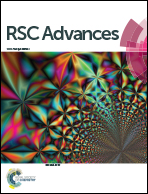A facile synthesis of hierarchically porous carbon derived from serum albumin by a generated-templating method for efficient oxygen reduction reaction†
Abstract
Hierarchically porous carbons (HPCs), with large specific surface area, abundant porous channels and adequate anchor points, act as one type of ideal carbon supports for the preparation of single-atom electrocatalysts. In this study, the blood plasma-derived HPC with an interconnected porous framework is constructed via a generated-template method, with the formation of ZnS nanoparticles from the abundant disulfide bonds (–S–S–) in serum albumin. After the thermal activation with heme-containing molecules (also from the bovine-blood biowaste), the HPC exhibits high-exposure and low-spin-state Fe(II)–N4 atomic active sites, and thereby presents a superior oxygen reduction reaction activity (the half wave potential of 0.87 V) and excellent stability (a 4 mV negative shift after 3000 potential cycles), even comparable with the benchmark Pt/C. This work delivers a new insight into the design and synthesis of porous carbons and carbon-based electrocatalysts to develop bio-derived materials in the field of clean energy conversion and storage.



 Please wait while we load your content...
Please wait while we load your content...